The 2005 Phoenix 200 is engineered by Polaris, built by Aeon in Taiwan. It is powered by an air-cooled 196 cc 4-stroke motor attached to a scaled-down version of Polaris's CVT transmission with forward, neutral and reverse. Gear selection is by a straight-throw lever that should be easy to use but did not provide for positive shifts. Occasionally you were required to rock the machine to get the transmission engaged. This happened in both forward and reverse, so I'm not sure even a linkage adjustment would totally solve the problem.
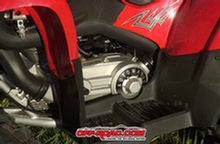 |
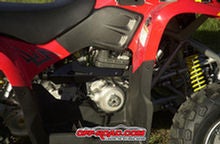 |
When I first picked up the Phoenix I was favorably impressed by the sporty good looks and wide stable stance. I was less impressed by the inability to climb the ramps into the back of my pickup. We had to push it into the bed. Needless to say the low end torque is unimpressive.
Once I got it onto the trails and dropped the needle one click, it woke the machine up. I was able to load without a push and the machine would get moving more briskly. For lighter riders the Phoenix would pull away quickly and accelerate briskly to its top speed of nearly 35 mph. I'd planned on tweaking the jetting a bit more as it was still running rich, but the dealer needed his machine back before I could fine tune.
|
|
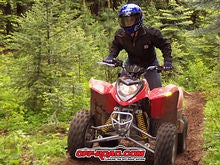 |
I was surprised by the amount of vibration coming from the engine. Near full throttle the vibration was very heavy, not so much through the bars but the seat and pegs. The vibration wasn't bothersome but Polaris needs to check the balance of the motor and CVT pulleys.
It features electric start with a kick-start back-up. The kick-starter is mounted to the rear sub frame above the swing arm pivot.
After accidentally leaving the key on overnight, I thought that this was the perfect opportunity to test the kick starter - first mistake. After using the supplied Erector Set tools to install the kick starter on the side of the CVT housing ( tools 2 knuckles 0) I assumed my difficulties were over. Wrong again. To kick the machine over you need to have either size 6 feet or place your heel on the lever. Once you master the foot placement, the lack of a return spring on the kick starter increases your frustration, since you must reach down after each aborted kick to pull the lever back to the top. If you happen to have this experience yourself, remember to move small children out of earshot. It will work in an emergency, but you're better off not letting the battery run down.
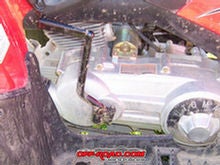 |
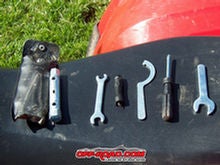 |
The front suspension is dual A-arms with better than 7 inches of travel. The shocks are only adjustable for spring preload. Even set to the softest setting, the front is too stiff for my 250 lbs. I could only use about 4 inches of travel when jumping the machine off of some small jumps.
The ride was firm but controllable on fire roads and the trails we took while testing. Lighter testers used almost as much wheel travel as I did while riding, but the harsh ride was not enjoyable.
The rear suspension is a none-linkage swing arm with the same shock as the front, with only preload adjustment. The rear suspension was easier to get used to because you could set the spring for a wider variety of rider weights. Full stiff worked for me and my wife liked the softest setting when she was trail riding.
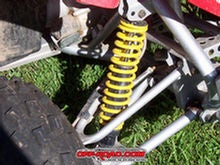 |
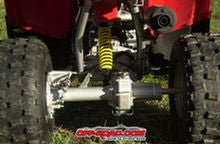 |
The first bright spot was that Polaris pulled out the stops with the front brakes, by installing the complete braking system off of the Predator. With braided steel lines the lever is very firm and fade-free when used as hard as possible with the limited power available to supply the go. The rear brake is a large sealed drum, actuated with either the left hand brake lever or the right foot brake.
Polaris fit low-profile tires front and rear on 10 inch and 9 inch wheels respectively. The supplied rubber performed well on the trails where we tested, but as with many quads, if you ride in a lot of rock you'll want to upgrade your rubber. With the standard size wheels it will be easy to upgrade the tires to suit your conditions.
The Phoenix offers an optional rear rack with a 70 lb capacity. They also offer a trailer hitch and rate the machine to tow 300 lbs. The Phoenix we tested was not equipped with either option so I was unable to test the towing claim.
The minimalist instrument panel informs you with lights of high temp, high beams, neutral and reverse. I took the Phoenix out for a night ride and realized that the lights are not nearly bright enough for anything but a fire road at a gentle pace.
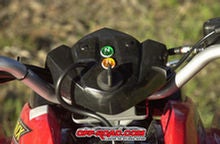 |
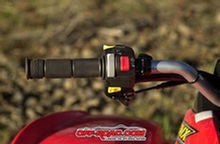 |
I really enjoyed riding the Phoenix on the fire roads and trails in the area. You could ride it flat out and rely on the suspension and excellent front brakes to scrub excess speed before hitting water bars or other rough stretches.
I didn't like the front suspension at slow speed, but the harder you pushed the machine the better it performed for me. Even pushed as hard as possible, with the limited engine power, you couldn't over ride it. With the top speed around 35 mph you really couldn't push that hard. With lighter riders the machine easily climbed the steepest hills within the riders capabilities if you had a little momentum. Starting from a dead stop was iffy from a power stand point, due to the sluggish bottom end.
A few suggestions for Polaris: First - Use lower rate front springs. Doing this would solve 75% of our complaints. You designed a good front end and then ruined it with overly stiff springs. Second - an increase in the final drive ratio for forward. This would give better throttle response and more bottom end power but sacrifice a bit of top speed. Not a bad thing considering the machine's target audience.
Polaris introduced the Phoenix for the rider looking for a sporty quad. I'm not sure they met that goal. For me the machine is under-powered and over-sprung.
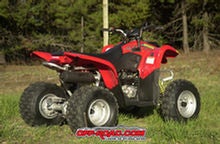 I've had some negative things to say about the
model, mostly about the minimal power, but it's the low power
combined with the excellent brakes and fair suspension that makes
this a perfect machine to learn on or step up to from a kids-sized
machine. My son loved the electric start and the racy look. Too bad
he's too young to enjoy the ride yet. If the issues listed above
were fixed, I would consider the Phoenix for my family.
I've had some negative things to say about the
model, mostly about the minimal power, but it's the low power
combined with the excellent brakes and fair suspension that makes
this a perfect machine to learn on or step up to from a kids-sized
machine. My son loved the electric start and the racy look. Too bad
he's too young to enjoy the ride yet. If the issues listed above
were fixed, I would consider the Phoenix for my family.


 Your Privacy Choices
Your Privacy Choices